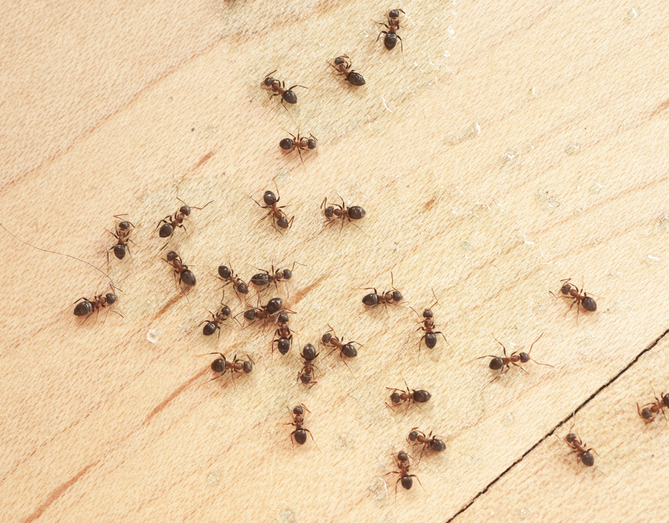How to Get Rid of Carpenter Ants
How to Get Rid of Carpenter Ants
To get rid of carpenter ants, start by maintaining a clean environment, promptly cleaning up food spills and storing food in airtight containers. Eliminate moisture by repairing leaks and ensuring proper ventilation in damp areas. Regularly inspect and seal potential entry points in your home’s exterior, including cracks and crevices. In your yard, trim vegetation away from the foundation and manage mulch to prevent moisture retention. For persistent infestations, consider professional treatments from trusted providers like Orkin, which offer targeted solutions to eradicate carpenter ant colonies effectively.
Understanding Carpenter Ants
Carpenter ants, often mistaken for regular ants, have unique behaviors and characteristics that set them apart. Their name is derived from their wood-excavating habits, which can lead to structural damage in homes. To effectively manage and prevent an infestation, it’s crucial to understand these ants thoroughly.
Physical Characteristics
- Size and Color – Carpenter ants are among the largest ants, ranging from 3.4 to 13 mm long. They can vary in color, from black to reddish-brown, depending on the species.
- Body Structure – Unlike termites, carpenter ants have a distinct narrow waist and a rounded thorax. Their antennae are bent or “elbowed.”

Save $50
on your first recurring service today with code GET50
Habitat and Nesting Behavior
- Natural Habitat – In nature, carpenter ants typically nest in damp, decaying wood. They prefer wooded areas and can often be found in tree stumps, logs, or fallen branches.
- Home Invasion – When they invade homes, they’re attracted to wood that’s been softened by moisture or decay. Common nesting sites include window frames, chimneys, sinks, doorframes, or roof eaves.
- Nest Creation – Unlike termites, carpenter ants don’t eat wood. Instead, they carve out galleries or tunnels in the wood to establish their nests. This excavation results in a smooth, sandpaper-like appearance inside the tunnels.

GET A PERSONALIZED QUOTE
To protect your home from pests, click here for a free pest control estimate. Our Orkin Pros will create a personalized pest treatment plan for your home or business
or Call (866) 249-0292
Diet and Life Cycle
- Varied Diet – Carpenter ants are omnivorous. They feed on a variety of foods, including other insects, plant juices, and human food, especially sweets and meats.
- Foraging Behavior – These ants are primarily nocturnal, venturing out of their nests at night to search for food. They often leave a trail of pheromones for other ants to follow, leading them to food sources.
- Colonies – A carpenter’s ant colony starts with a single queen. After mating, the queen finds a suitable nesting site and lays her eggs.
- Development – The eggs hatch into larvae, which are fed and cared for by the queen. The larvae then pupate and eventually emerge as adult ants. This process can take several weeks to months.
- Colony Expansion – As the colony grows, it may establish satellite nests in nearby areas. These satellite nests are extensions of the main colony and can be found both indoors and outdoors.
Signs of Infestation
- Frass – One of the most noticeable signs of a carpenter ant infestation is the presence of “frass” or sawdust-like debris. This is the result of their excavation activities.
- Noises – In quiet conditions, homeowners might hear faint rustling sounds within walls or woodwork, indicating the ants are active inside.
- Visible Ants – Seeing large, winged ants indoors, especially during spring, can be a sign of an established colony nearby.
Effective Measures to Control Carpenter Ants
Maintain a Clean Environment and Eliminate Moisture
Carpenter ants are attracted to food sources. Make sure that any food spills, especially sugary substances or proteins, are cleaned up immediately. Store food items, especially sweets and meats, in airtight containers. This not only keeps ants out but also prevents them from detecting food sources. Empty trash bins regularly and ensure they are sealed properly to prevent ants from accessing food waste.
Periodically inspect your home for damp areas, especially basements, attics, and bathrooms. These moist areas are prime locations for carpenter ants to establish colonies. Repair any plumbing issues or roof leaks promptly. Water-damaged wood is softer and easier for carpenter ants to excavate. Ensure that areas like basements and crawl spaces are well-ventilated to reduce humidity and moisture.
Seal Entry Points and Landscape Maintenance
Regularly inspect your home’s exterior for cracks, crevices, and holes. Seal any potential entry points using caulk or other sealants. Ensure that window and door frames fit snugly. Replace any damaged or worn-out weather stripping. Check where utility lines (water, gas, electricity) enter your home. Ensure that gaps around these entry points are sealed.
Keep shrubs, trees, and other vegetation trimmed and away from your home’s foundation. Overhanging branches can act as bridges for ants to enter your home. While mulch can beautify a landscape, it can also retain moisture. Consider using less moisture-retentive alternatives near your home’s foundation or ensure it’s not piled too high against the siding. Remove any fallen wood, debris, or stumps from your yard. These can act as potential nesting sites for carpenter ants.
Professional Inspections and Treatments
- Routine Inspections – Consider having a professional from Orkin inspect your home periodically. They can identify potential risks and provide recommendations.
- Targeted Treatments – If an infestation is detected, Orkin professionals can provide targeted treatments, ensuring the entire colony is eradicated without causing harm to your home’s environment.
- Follow-up – After treatment, regular follow-ups can ensure that the carpenter ant problem doesn’t recur.
Orkin’s Advanced Treatment Options
- bait stations – We strategically place bait stations where ants have been observed. Our baits are designed to be attractive to ants, ensuring they carry it back to their colony, effectively eliminating the entire nest.
- Contact Insecticides – Orkin uses non-repellent contact insecticides, which are highly effective in creating barriers around your home. These barriers prevent ant invasions and ensure long-term protection.
- Professional Assistance – For severe infestations, especially when nests are hard to locate, our trained professionals can apply specialized treatments to ensure the colony is eradicated.
Frequently Asked Questions
What attracts carpenter ants to my home?
Carpenter ants are attracted to moist wood, food sources, and areas that provide them with shelter.
How can I differentiate between carpenter ants and termites?
Carpenter ants have a narrow waist, elbowed antennae, and their hind wings are shorter than their front wings. Termites have straight antennae and wings of equal size.
How long does it take to eliminate a carpenter ant colony?
With a thorough baiting program, it typically takes 3 to 4 weeks.
Are all ants harmful?
No, most ant species are beneficial in the landscape. However, certain species, like carpenter ants, can be destructive.
How often should I get my home treated for carpenter ants?
Regular inspections and treatments are recommended, especially if you’ve had a previous infestation.
Can I treat carpenter ants myself?
While there are DIY methods available, for a comprehensive solution, it’s best to consult professionals like Orkin.
What makes Orkin’s treatment methods unique?
At Orkin, we use a combination of research-backed methods and tailor our treatments to each home’s specific needs.
Are Orkin’s treatments safe for my family and pets?
Yes, all our treatments are designed to be safe for both humans and pets.
Conclusion
Controlling carpenter ants requires a combination of preventive measures and timely interventions. By understanding their behavior and being proactive, homeowners can protect their homes from these wood-destroying pests. And remember, when in doubt, Orkin is always here to assist with expert solutions.
Call Orkin for Comprehensive Carpenter Ant Solutions
Don’t let carpenter ants undermine the safety of your home. Trust in Orkin’s expertise to provide you with long-lasting solutions. Remember, when it comes to pests, Orkin knows best. Call us today for a consultation and let us help you reclaim your home from these pesky invaders.

FIND YOUR LOCAL BRANCH
To protect your home from pests, click here for a free pest control estimate. Our Orkin Pros will create a personalized pest treatment plan for your home or business
or Call (866) 249-0292

